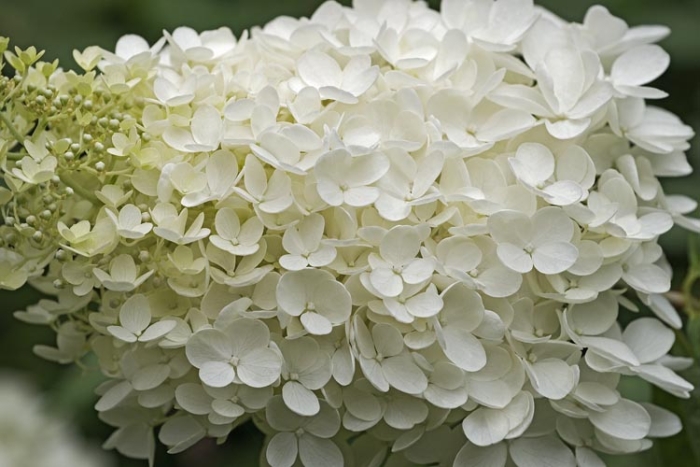Panicled Hydrangea
(Hydrangea paniculata)
Panicled Hydrangea (Hydrangea paniculata)
/
/

Dr. Nick V. Kurzenko
Public Domain
Image By:
Dr. Nick V. Kurzenko
Recorded By:
Copyright:
Public Domain
Copyright Notice:
Photo by: Dr. Nick V. Kurzenko | License Type: Public Domain | License URL: http://creativecommons.org/licenses/publicdomain/ | Attribution: 2011 Nick Kurzenko | Publisher: Calphotos |













































































Estimated Native Range
Summary
Hydrangea paniculata, commonly known as Panicled Hydrangea, is a deciduous shrub native to open woodlands and forest edges in East Asia, including China, Korea, Japan, and the Russian Far East. It typically grows to a height of 8-15 feet and a width of 6-12 feet, with a rounded form. The shrub is known for its large conical panicles of flowers that bloom in late summer. These panicles consist of creamy white fertile flowers and pinkish-white sterile florets, which may open pale green and age to white, creating a striking two-tone effect. The flowers are particularly showy and can be a focal point in the garden.
Panicled Hydrangea is valued for its ease of maintenance and the dramatic floral display that can enhance any garden setting. It is commonly used as a specimen plant, in mixed borders, or as a foundation planting. It can also be used for cut flowers. This shrub prefers full sun to part shade and adapts to a range of soil types, provided they have good drainage. It is drought-tolerant once established but benefits from medium water availability. Pruning in late winter or early spring can encourage larger flower heads. While generally disease-resistant, it can be susceptible to leaf spot and powdery mildew. It is also potentially invasive in some regions, so gardeners should check local guidelines before planting.CC BY-SA 4.0
Panicled Hydrangea is valued for its ease of maintenance and the dramatic floral display that can enhance any garden setting. It is commonly used as a specimen plant, in mixed borders, or as a foundation planting. It can also be used for cut flowers. This shrub prefers full sun to part shade and adapts to a range of soil types, provided they have good drainage. It is drought-tolerant once established but benefits from medium water availability. Pruning in late winter or early spring can encourage larger flower heads. While generally disease-resistant, it can be susceptible to leaf spot and powdery mildew. It is also potentially invasive in some regions, so gardeners should check local guidelines before planting.CC BY-SA 4.0
Plant Description
- Plant Type: Shrub
- Height: 8-15 feet
- Width: 6-12 feet
- Growth Rate: Rapid
- Flower Color: White, Pink
- Flowering Season: Summer, Fall
- Leaf Retention: Deciduous
Growth Requirements
- Sun: Full Sun, Part Shade
- Water: Medium
- Drainage: Slow, Medium, Fast
Common Uses
Bee Garden, Border Plant, Butterfly Garden, Fragrant, Potted Plant, Showy Flowers, Street Planting, Water Garden
Natural Habitat
Open woodlands and forest edges in East Asia
Other Names
Common Names: Paniculate Hydrangea, Peegee Hydrangea, Hortensia En Panicule, Hortensia Paniculé, Vipphortensia, 나무수국, 水亞木
Scientific Names: , Hydrangea paniculata, Hydrangea paniculata f. velutina, Heteromalla paniculata, Hydrangea paniculata f. grandiflora, Hydrangea paniculata var. praecox, Hydrangea paniculata var. debilis, Hydrangea paniculata var. velutina, Hydrangea sachalinensis, Hydrangea schindleri
GBIF Accepted Name: Hydrangea paniculata Siebold